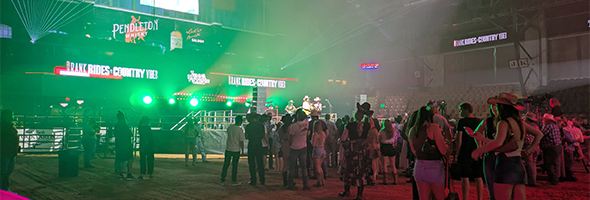
A historic stage with a modern experience falling short.
Cowtown Coliseum isn’t just another venue—it’s a legacy. Nestled in the Fort Worth Stockyards and steeped in over a century of history, it’s where America’s first indoor rodeo was held and where legends like Elvis and Roosevelt left their mark. But as the venue continued evolving—now hosting high-energy PBR competitions, concerts, and community events—its sound system couldn’t keep pace.
Guests seated just feet apart had drastically different audio experiences. Line arrays were outdated, coverage was inconsistent, and neither the audience nor the arena floor staff could clearly hear the show. In a place where performance is everything, the sound wasn’t doing the story justice.

Precision modeling. Flexible control. Stadium-sized confidence.
Using Meyer Sound’s MAPP 3D technology, we modeled the unique acoustics of Cowtown in advance, crafting a system that not only reached every corner of the venue—but optimized speech intelligibility and musical power for every use case.
We implemented a flexible control backbone that lets Cowtown staff adapt instantly to a night’s programming. Whether it’s a rodeo announcer or a high-decibel concert, each sound profile is fully time-aligned for maximum clarity and punch.
Every part of the system was chosen and tuned for performance and preservation. The gear disappears into the environment visually—but fills it with a new level of presence. Now, Cowtown has a modernized, multi-use sound system that amplifies its legendary spirit, not just the volume.



Reimagining coverage without compromising character.
Our mission was to deliver impactful, full-venue sound that could flex across the diverse needs of the space—rodeo one hour, rock concert the next—while honoring Cowtown’s Mission Revival architecture.
We designed a Meyer Sound point-source and distributed system that blends modern clarity with architectural subtlety. Smaller, powerful loudspeakers were strategically placed throughout the venue, replacing bulky, uneven line arrays. The result? A clear, consistent sonic experience in every seat—without intruding on the venue’s historic charm.
For the first time ever, performers and staff in the back chutes and arena floor could hear the show in real-time. That alone changed the game for execution, energy, and safety.